Law Assignment: Aggression, IHL, State Responsibility, and Treaties
VerifiedAdded on 2020/03/28
|9
|1817
|97
Report
AI Summary
This law assignment explores several key areas of international law. Part A defines aggression, referencing the UN Charter and providing examples of aggressive acts, while also noting exceptions. Part B discusses international humanitarian law (IHL), its role in regulating armed conflict, protecting non-combatants, and the importance of treaties and customary law. Part C focuses on state responsibility for violations of IHL, detailing the actions and entities that can lead to state accountability. Answer 3 delves into international law sources, including treaties and customary law, comparing their creation and enforcement. It also provides a case study on the US invasion of Panama, discussing the legal basis for the invasion, the Hay-Herrán and Hay-Bunau-Varilla Treaties, and the conditions for the Panama Canal Treaty's validity. The assignment draws on various sources, including UN documents, ICRC publications, and scholarly articles.

Running Head: Law 1
Law
Law
Paraphrase This Document
Need a fresh take? Get an instant paraphrase of this document with our AI Paraphraser
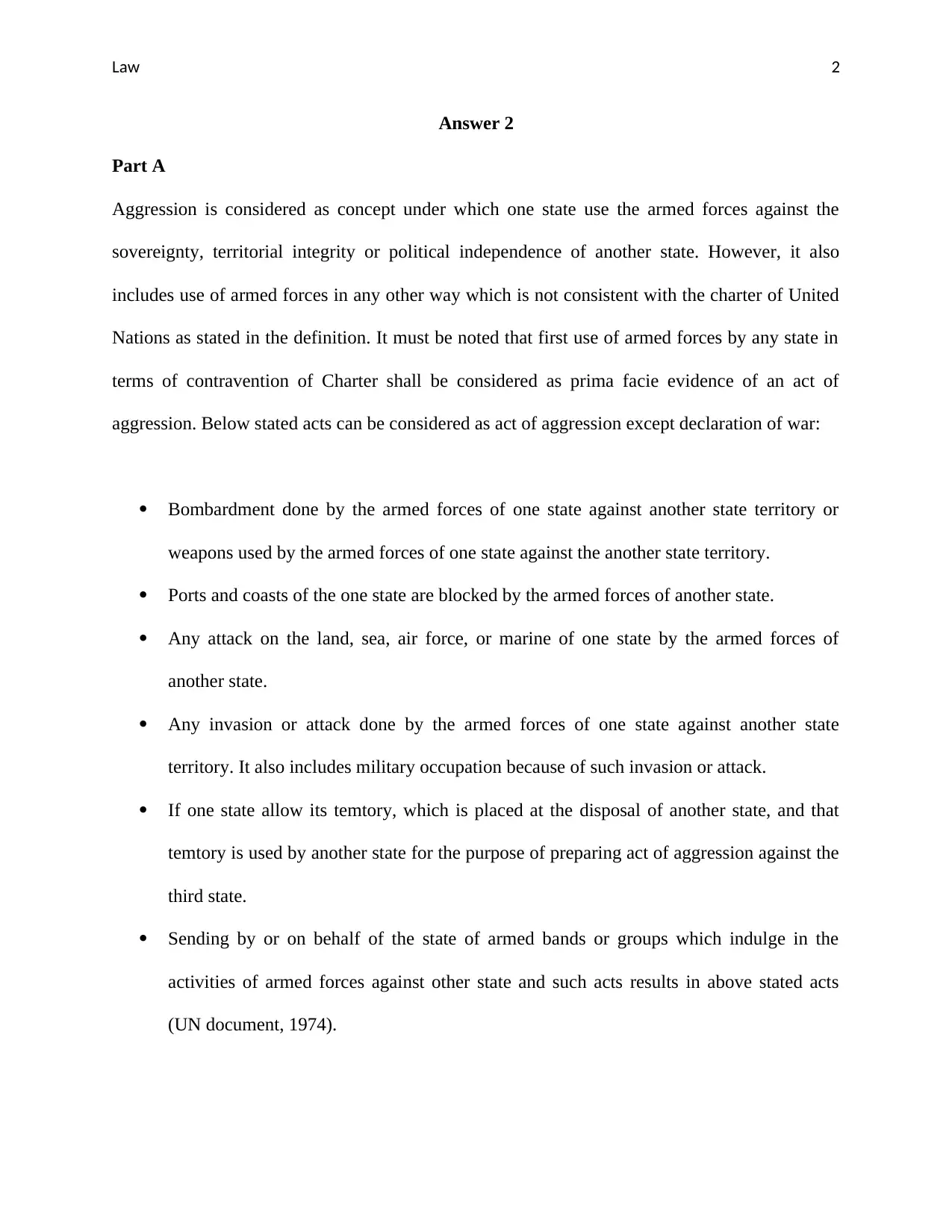
Law 2
Answer 2
Part A
Aggression is considered as concept under which one state use the armed forces against the
sovereignty, territorial integrity or political independence of another state. However, it also
includes use of armed forces in any other way which is not consistent with the charter of United
Nations as stated in the definition. It must be noted that first use of armed forces by any state in
terms of contravention of Charter shall be considered as prima facie evidence of an act of
aggression. Below stated acts can be considered as act of aggression except declaration of war:
Bombardment done by the armed forces of one state against another state territory or
weapons used by the armed forces of one state against the another state territory.
Ports and coasts of the one state are blocked by the armed forces of another state.
Any attack on the land, sea, air force, or marine of one state by the armed forces of
another state.
Any invasion or attack done by the armed forces of one state against another state
territory. It also includes military occupation because of such invasion or attack.
If one state allow its temtory, which is placed at the disposal of another state, and that
temtory is used by another state for the purpose of preparing act of aggression against the
third state.
Sending by or on behalf of the state of armed bands or groups which indulge in the
activities of armed forces against other state and such acts results in above stated acts
(UN document, 1974).
Answer 2
Part A
Aggression is considered as concept under which one state use the armed forces against the
sovereignty, territorial integrity or political independence of another state. However, it also
includes use of armed forces in any other way which is not consistent with the charter of United
Nations as stated in the definition. It must be noted that first use of armed forces by any state in
terms of contravention of Charter shall be considered as prima facie evidence of an act of
aggression. Below stated acts can be considered as act of aggression except declaration of war:
Bombardment done by the armed forces of one state against another state territory or
weapons used by the armed forces of one state against the another state territory.
Ports and coasts of the one state are blocked by the armed forces of another state.
Any attack on the land, sea, air force, or marine of one state by the armed forces of
another state.
Any invasion or attack done by the armed forces of one state against another state
territory. It also includes military occupation because of such invasion or attack.
If one state allow its temtory, which is placed at the disposal of another state, and that
temtory is used by another state for the purpose of preparing act of aggression against the
third state.
Sending by or on behalf of the state of armed bands or groups which indulge in the
activities of armed forces against other state and such acts results in above stated acts
(UN document, 1974).
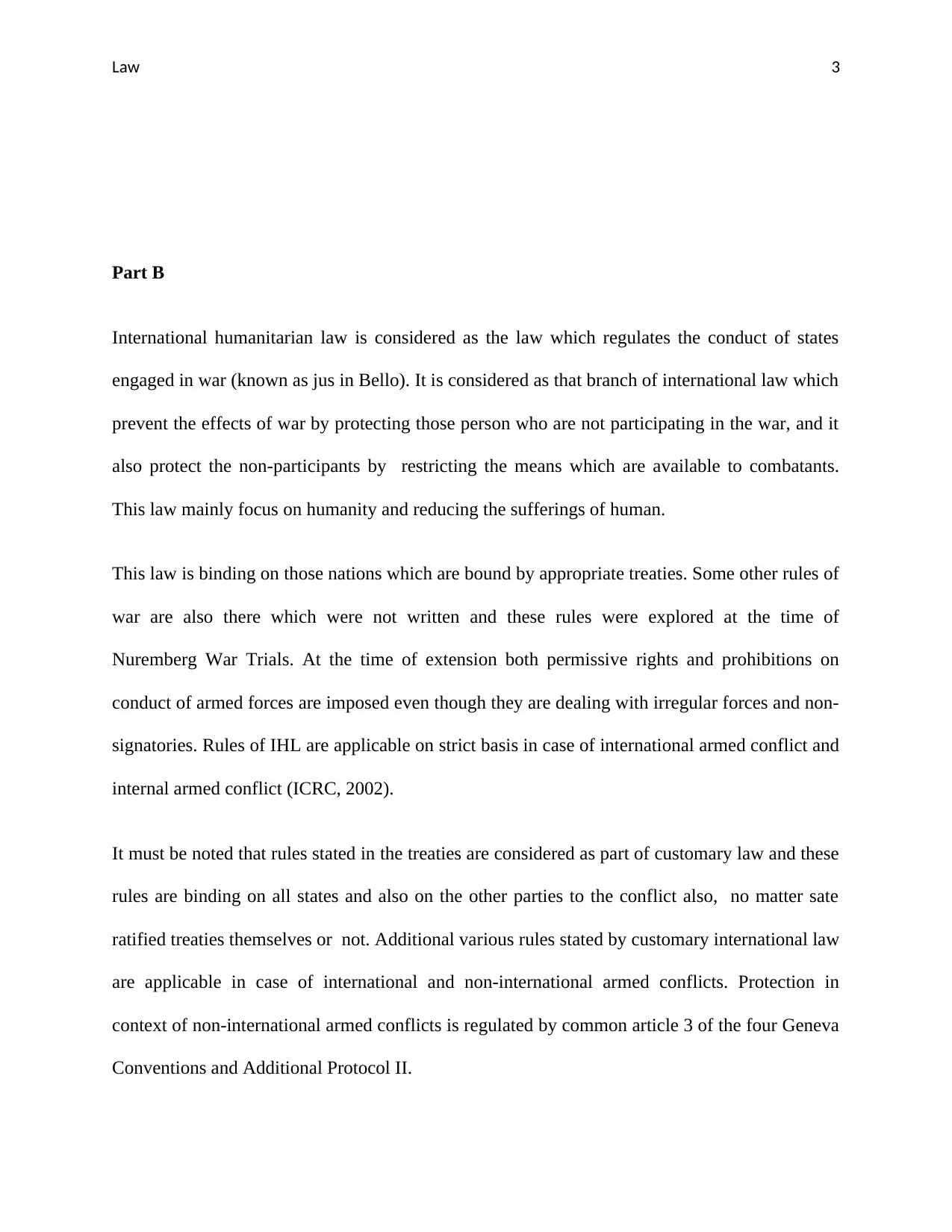
Law 3
Part B
International humanitarian law is considered as the law which regulates the conduct of states
engaged in war (known as jus in Bello). It is considered as that branch of international law which
prevent the effects of war by protecting those person who are not participating in the war, and it
also protect the non-participants by restricting the means which are available to combatants.
This law mainly focus on humanity and reducing the sufferings of human.
This law is binding on those nations which are bound by appropriate treaties. Some other rules of
war are also there which were not written and these rules were explored at the time of
Nuremberg War Trials. At the time of extension both permissive rights and prohibitions on
conduct of armed forces are imposed even though they are dealing with irregular forces and non-
signatories. Rules of IHL are applicable on strict basis in case of international armed conflict and
internal armed conflict (ICRC, 2002).
It must be noted that rules stated in the treaties are considered as part of customary law and these
rules are binding on all states and also on the other parties to the conflict also, no matter sate
ratified treaties themselves or not. Additional various rules stated by customary international law
are applicable in case of international and non-international armed conflicts. Protection in
context of non-international armed conflicts is regulated by common article 3 of the four Geneva
Conventions and Additional Protocol II.
Part B
International humanitarian law is considered as the law which regulates the conduct of states
engaged in war (known as jus in Bello). It is considered as that branch of international law which
prevent the effects of war by protecting those person who are not participating in the war, and it
also protect the non-participants by restricting the means which are available to combatants.
This law mainly focus on humanity and reducing the sufferings of human.
This law is binding on those nations which are bound by appropriate treaties. Some other rules of
war are also there which were not written and these rules were explored at the time of
Nuremberg War Trials. At the time of extension both permissive rights and prohibitions on
conduct of armed forces are imposed even though they are dealing with irregular forces and non-
signatories. Rules of IHL are applicable on strict basis in case of international armed conflict and
internal armed conflict (ICRC, 2002).
It must be noted that rules stated in the treaties are considered as part of customary law and these
rules are binding on all states and also on the other parties to the conflict also, no matter sate
ratified treaties themselves or not. Additional various rules stated by customary international law
are applicable in case of international and non-international armed conflicts. Protection in
context of non-international armed conflicts is regulated by common article 3 of the four Geneva
Conventions and Additional Protocol II.
⊘ This is a preview!⊘
Do you want full access?
Subscribe today to unlock all pages.

Trusted by 1+ million students worldwide
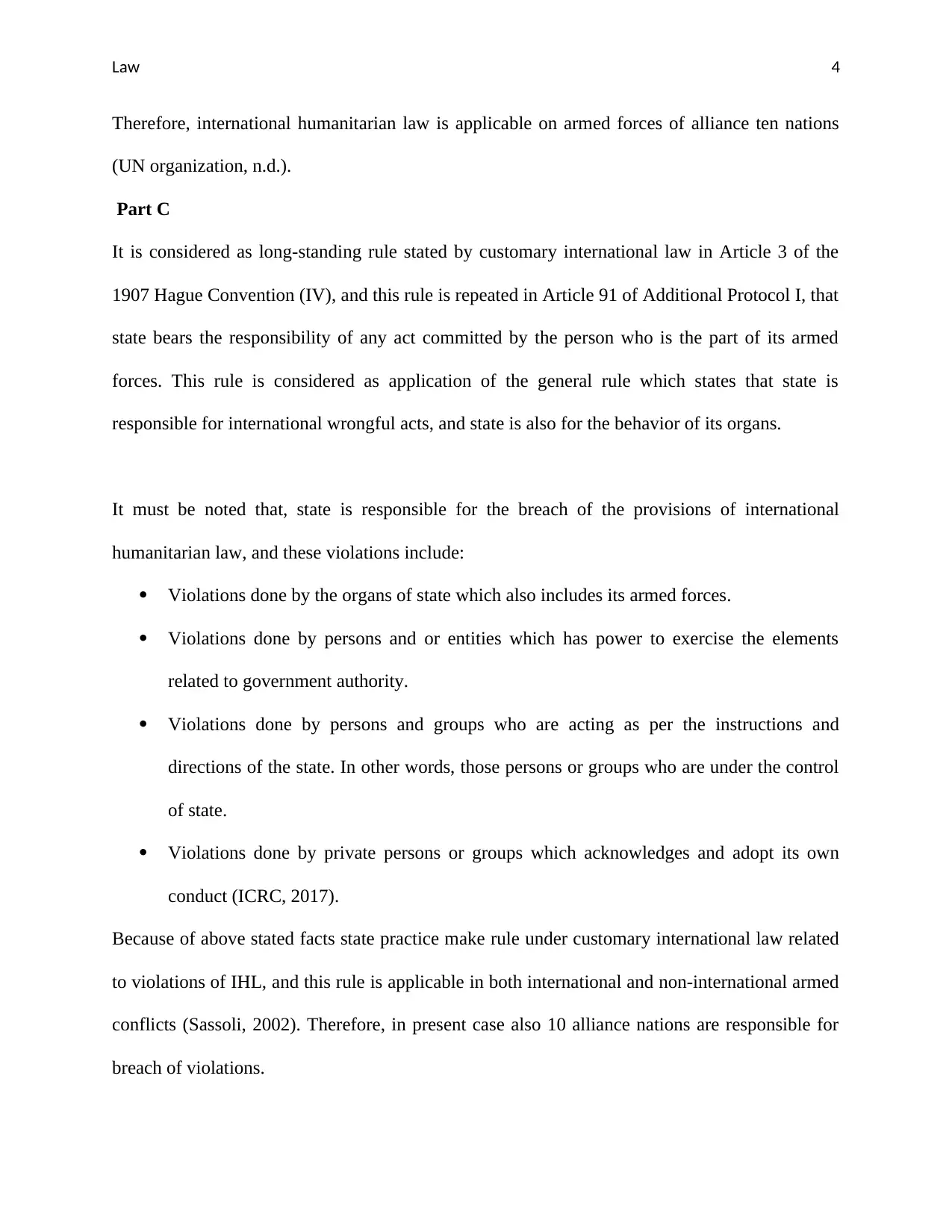
Law 4
Therefore, international humanitarian law is applicable on armed forces of alliance ten nations
(UN organization, n.d.).
Part C
It is considered as long-standing rule stated by customary international law in Article 3 of the
1907 Hague Convention (IV), and this rule is repeated in Article 91 of Additional Protocol I, that
state bears the responsibility of any act committed by the person who is the part of its armed
forces. This rule is considered as application of the general rule which states that state is
responsible for international wrongful acts, and state is also for the behavior of its organs.
It must be noted that, state is responsible for the breach of the provisions of international
humanitarian law, and these violations include:
Violations done by the organs of state which also includes its armed forces.
Violations done by persons and or entities which has power to exercise the elements
related to government authority.
Violations done by persons and groups who are acting as per the instructions and
directions of the state. In other words, those persons or groups who are under the control
of state.
Violations done by private persons or groups which acknowledges and adopt its own
conduct (ICRC, 2017).
Because of above stated facts state practice make rule under customary international law related
to violations of IHL, and this rule is applicable in both international and non-international armed
conflicts (Sassoli, 2002). Therefore, in present case also 10 alliance nations are responsible for
breach of violations.
Therefore, international humanitarian law is applicable on armed forces of alliance ten nations
(UN organization, n.d.).
Part C
It is considered as long-standing rule stated by customary international law in Article 3 of the
1907 Hague Convention (IV), and this rule is repeated in Article 91 of Additional Protocol I, that
state bears the responsibility of any act committed by the person who is the part of its armed
forces. This rule is considered as application of the general rule which states that state is
responsible for international wrongful acts, and state is also for the behavior of its organs.
It must be noted that, state is responsible for the breach of the provisions of international
humanitarian law, and these violations include:
Violations done by the organs of state which also includes its armed forces.
Violations done by persons and or entities which has power to exercise the elements
related to government authority.
Violations done by persons and groups who are acting as per the instructions and
directions of the state. In other words, those persons or groups who are under the control
of state.
Violations done by private persons or groups which acknowledges and adopt its own
conduct (ICRC, 2017).
Because of above stated facts state practice make rule under customary international law related
to violations of IHL, and this rule is applicable in both international and non-international armed
conflicts (Sassoli, 2002). Therefore, in present case also 10 alliance nations are responsible for
breach of violations.
Paraphrase This Document
Need a fresh take? Get an instant paraphrase of this document with our AI Paraphraser

Law 5
Answer 3
Part A
International law sources includes treaties, international customs, general principles of law which
are recognized by civil nations, etc. some treaties are generated from the codifying existing
customary law such as law governing the global commons and also Jus ad bellum. However, the
main aim of customary law is to establish the code of general application, and its effectiveness is
completely depend on the number of states which ratify that particular convention. It must be
noted that few of these instruments have sufficient number of parties which entitled international
law.
(1) Treaties and customary international law are considered as different but important
lawmaking process. It must be noted that these process are not so much different in terms
of compliance and enforcement. In fact state practice does not show the difference
between the creation of customary law and treaty. Difference between the two can be
understood as, customary law is considered as general practices which are accepted as
law and treaties are those principles which permit the set of exclusion and agenda control
devices which are not present in the customary law (Meyer, 2015).
(2) Customary international law is defined in Article 38(1) (b) by international Court of
Justice as “evidence related to general practice which is accepted as law”. Usually,
customary law is defined through two factors that is general principles defined as states
and what is accepted by state as law. There are different types of customary law which
Answer 3
Part A
International law sources includes treaties, international customs, general principles of law which
are recognized by civil nations, etc. some treaties are generated from the codifying existing
customary law such as law governing the global commons and also Jus ad bellum. However, the
main aim of customary law is to establish the code of general application, and its effectiveness is
completely depend on the number of states which ratify that particular convention. It must be
noted that few of these instruments have sufficient number of parties which entitled international
law.
(1) Treaties and customary international law are considered as different but important
lawmaking process. It must be noted that these process are not so much different in terms
of compliance and enforcement. In fact state practice does not show the difference
between the creation of customary law and treaty. Difference between the two can be
understood as, customary law is considered as general practices which are accepted as
law and treaties are those principles which permit the set of exclusion and agenda control
devices which are not present in the customary law (Meyer, 2015).
(2) Customary international law is defined in Article 38(1) (b) by international Court of
Justice as “evidence related to general practice which is accepted as law”. Usually,
customary law is defined through two factors that is general principles defined as states
and what is accepted by state as law. There are different types of customary law which
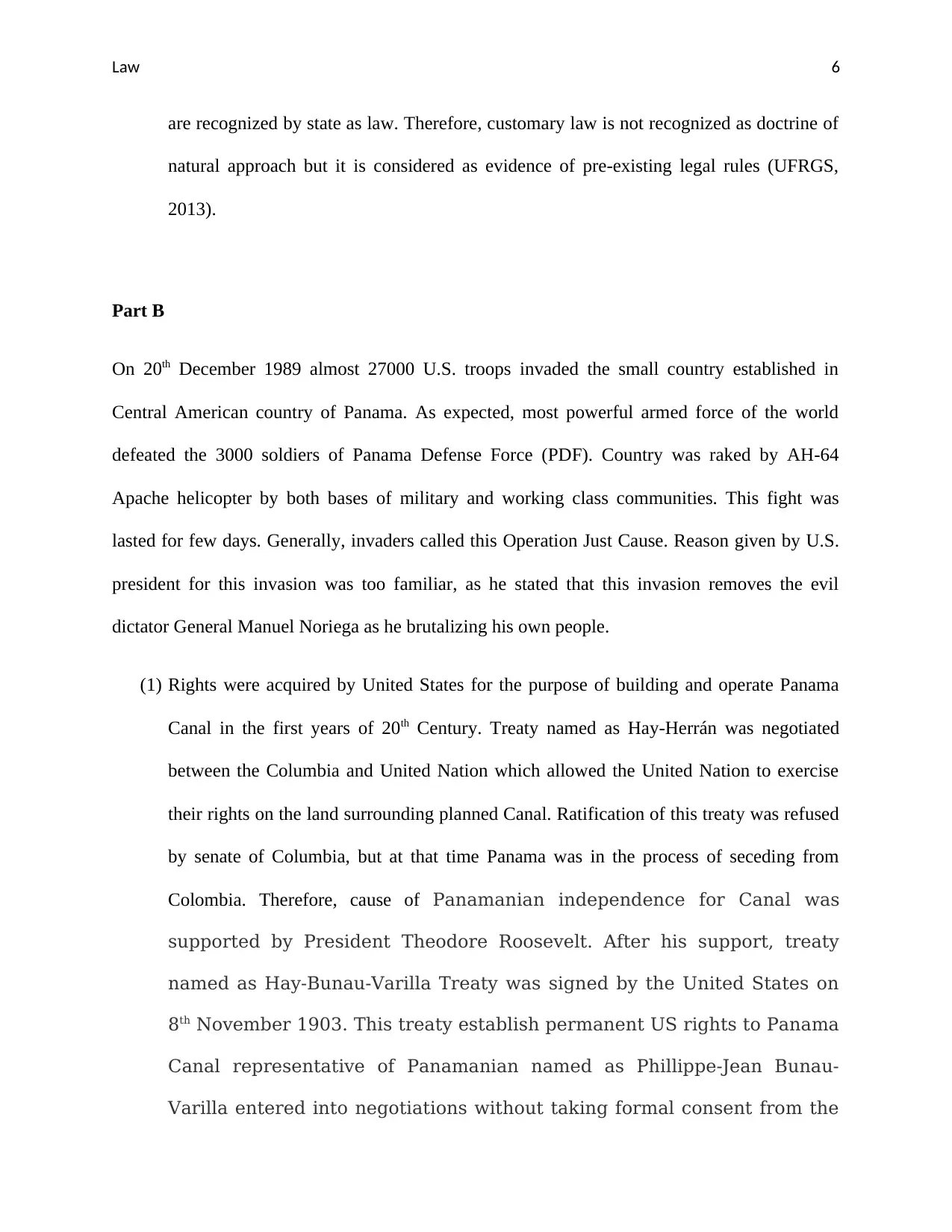
Law 6
are recognized by state as law. Therefore, customary law is not recognized as doctrine of
natural approach but it is considered as evidence of pre-existing legal rules (UFRGS,
2013).
Part B
On 20th December 1989 almost 27000 U.S. troops invaded the small country established in
Central American country of Panama. As expected, most powerful armed force of the world
defeated the 3000 soldiers of Panama Defense Force (PDF). Country was raked by AH-64
Apache helicopter by both bases of military and working class communities. This fight was
lasted for few days. Generally, invaders called this Operation Just Cause. Reason given by U.S.
president for this invasion was too familiar, as he stated that this invasion removes the evil
dictator General Manuel Noriega as he brutalizing his own people.
(1) Rights were acquired by United States for the purpose of building and operate Panama
Canal in the first years of 20th Century. Treaty named as Hay-Herrán was negotiated
between the Columbia and United Nation which allowed the United Nation to exercise
their rights on the land surrounding planned Canal. Ratification of this treaty was refused
by senate of Columbia, but at that time Panama was in the process of seceding from
Colombia. Therefore, cause of Panamanian independence for Canal was
supported by President Theodore Roosevelt. After his support, treaty
named as Hay-Bunau-Varilla Treaty was signed by the United States on
8th November 1903. This treaty establish permanent US rights to Panama
Canal representative of Panamanian named as Phillippe-Jean Bunau-
Varilla entered into negotiations without taking formal consent from the
are recognized by state as law. Therefore, customary law is not recognized as doctrine of
natural approach but it is considered as evidence of pre-existing legal rules (UFRGS,
2013).
Part B
On 20th December 1989 almost 27000 U.S. troops invaded the small country established in
Central American country of Panama. As expected, most powerful armed force of the world
defeated the 3000 soldiers of Panama Defense Force (PDF). Country was raked by AH-64
Apache helicopter by both bases of military and working class communities. This fight was
lasted for few days. Generally, invaders called this Operation Just Cause. Reason given by U.S.
president for this invasion was too familiar, as he stated that this invasion removes the evil
dictator General Manuel Noriega as he brutalizing his own people.
(1) Rights were acquired by United States for the purpose of building and operate Panama
Canal in the first years of 20th Century. Treaty named as Hay-Herrán was negotiated
between the Columbia and United Nation which allowed the United Nation to exercise
their rights on the land surrounding planned Canal. Ratification of this treaty was refused
by senate of Columbia, but at that time Panama was in the process of seceding from
Colombia. Therefore, cause of Panamanian independence for Canal was
supported by President Theodore Roosevelt. After his support, treaty
named as Hay-Bunau-Varilla Treaty was signed by the United States on
8th November 1903. This treaty establish permanent US rights to Panama
Canal representative of Panamanian named as Phillippe-Jean Bunau-
Varilla entered into negotiations without taking formal consent from the
⊘ This is a preview!⊘
Do you want full access?
Subscribe today to unlock all pages.

Trusted by 1+ million students worldwide
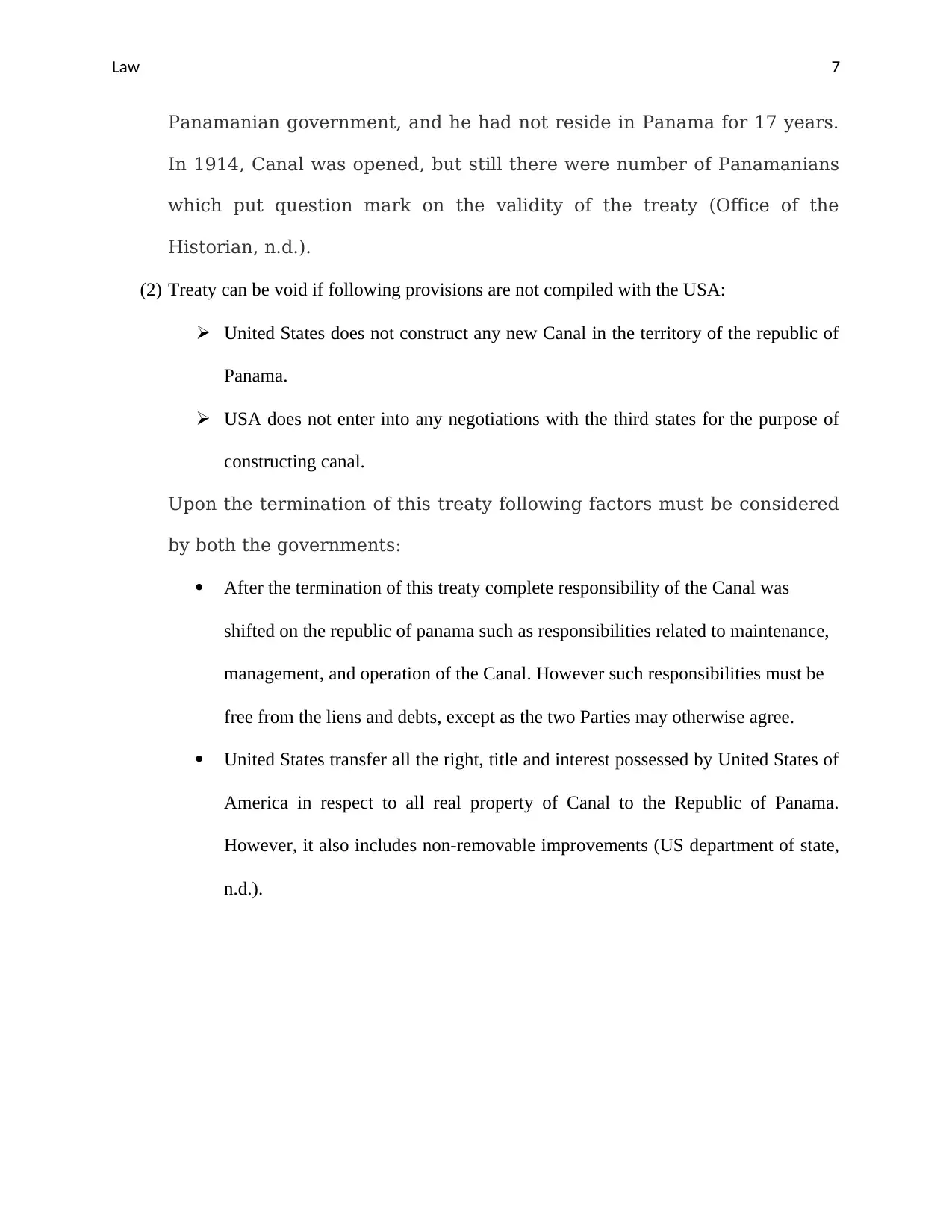
Law 7
Panamanian government, and he had not reside in Panama for 17 years.
In 1914, Canal was opened, but still there were number of Panamanians
which put question mark on the validity of the treaty (Office of the
Historian, n.d.).
(2) Treaty can be void if following provisions are not compiled with the USA:
United States does not construct any new Canal in the territory of the republic of
Panama.
USA does not enter into any negotiations with the third states for the purpose of
constructing canal.
Upon the termination of this treaty following factors must be considered
by both the governments:
After the termination of this treaty complete responsibility of the Canal was
shifted on the republic of panama such as responsibilities related to maintenance,
management, and operation of the Canal. However such responsibilities must be
free from the liens and debts, except as the two Parties may otherwise agree.
United States transfer all the right, title and interest possessed by United States of
America in respect to all real property of Canal to the Republic of Panama.
However, it also includes non-removable improvements (US department of state,
n.d.).
Panamanian government, and he had not reside in Panama for 17 years.
In 1914, Canal was opened, but still there were number of Panamanians
which put question mark on the validity of the treaty (Office of the
Historian, n.d.).
(2) Treaty can be void if following provisions are not compiled with the USA:
United States does not construct any new Canal in the territory of the republic of
Panama.
USA does not enter into any negotiations with the third states for the purpose of
constructing canal.
Upon the termination of this treaty following factors must be considered
by both the governments:
After the termination of this treaty complete responsibility of the Canal was
shifted on the republic of panama such as responsibilities related to maintenance,
management, and operation of the Canal. However such responsibilities must be
free from the liens and debts, except as the two Parties may otherwise agree.
United States transfer all the right, title and interest possessed by United States of
America in respect to all real property of Canal to the Republic of Panama.
However, it also includes non-removable improvements (US department of state,
n.d.).
Paraphrase This Document
Need a fresh take? Get an instant paraphrase of this document with our AI Paraphraser
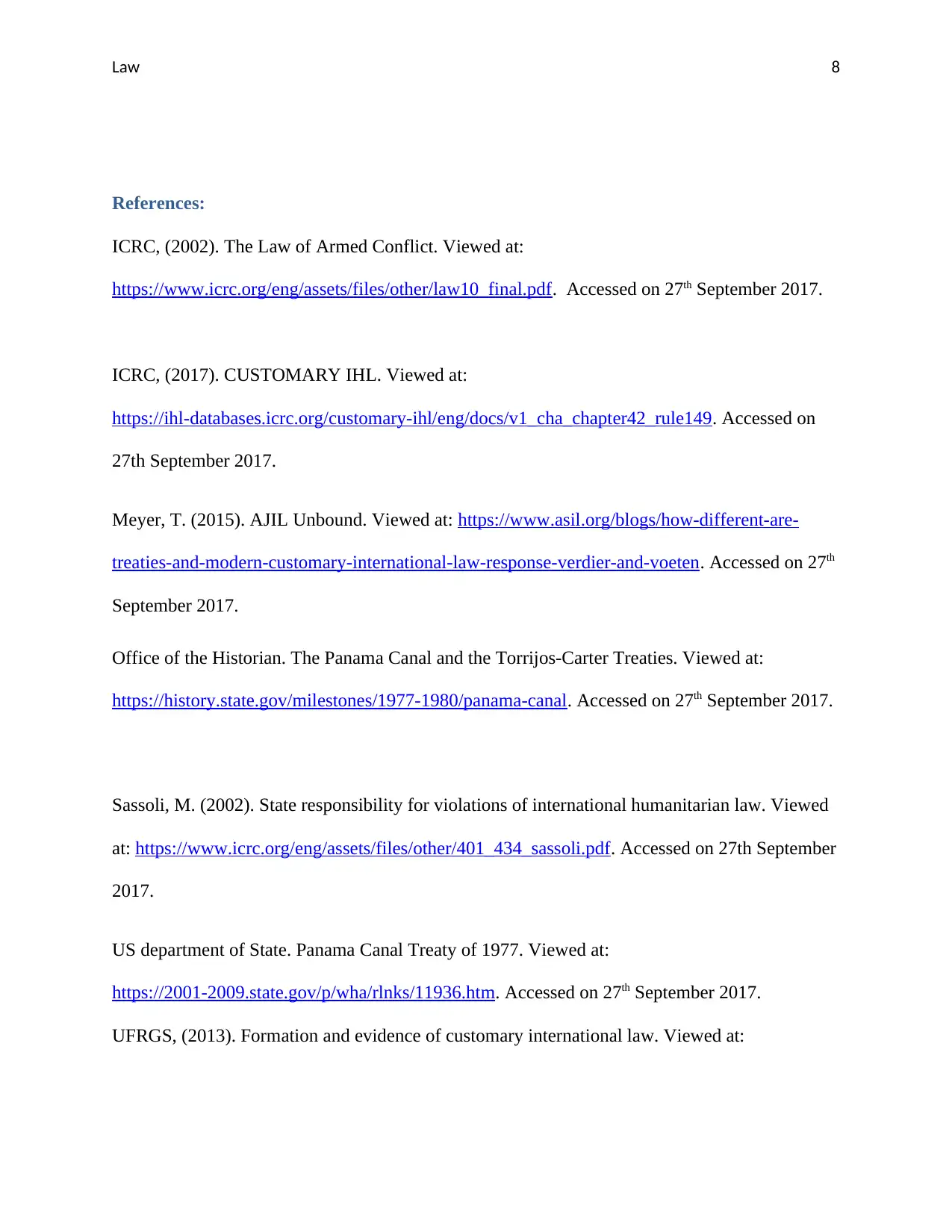
Law 8
References:
ICRC, (2002). The Law of Armed Conflict. Viewed at:
https://www.icrc.org/eng/assets/files/other/law10_final.pdf. Accessed on 27th September 2017.
ICRC, (2017). CUSTOMARY IHL. Viewed at:
https://ihl-databases.icrc.org/customary-ihl/eng/docs/v1_cha_chapter42_rule149. Accessed on
27th September 2017.
Meyer, T. (2015). AJIL Unbound. Viewed at: https://www.asil.org/blogs/how-different-are-
treaties-and-modern-customary-international-law-response-verdier-and-voeten. Accessed on 27th
September 2017.
Office of the Historian. The Panama Canal and the Torrijos-Carter Treaties. Viewed at:
https://history.state.gov/milestones/1977-1980/panama-canal. Accessed on 27th September 2017.
Sassoli, M. (2002). State responsibility for violations of international humanitarian law. Viewed
at: https://www.icrc.org/eng/assets/files/other/401_434_sassoli.pdf. Accessed on 27th September
2017.
US department of State. Panama Canal Treaty of 1977. Viewed at:
https://2001-2009.state.gov/p/wha/rlnks/11936.htm. Accessed on 27th September 2017.
UFRGS, (2013). Formation and evidence of customary international law. Viewed at:
References:
ICRC, (2002). The Law of Armed Conflict. Viewed at:
https://www.icrc.org/eng/assets/files/other/law10_final.pdf. Accessed on 27th September 2017.
ICRC, (2017). CUSTOMARY IHL. Viewed at:
https://ihl-databases.icrc.org/customary-ihl/eng/docs/v1_cha_chapter42_rule149. Accessed on
27th September 2017.
Meyer, T. (2015). AJIL Unbound. Viewed at: https://www.asil.org/blogs/how-different-are-
treaties-and-modern-customary-international-law-response-verdier-and-voeten. Accessed on 27th
September 2017.
Office of the Historian. The Panama Canal and the Torrijos-Carter Treaties. Viewed at:
https://history.state.gov/milestones/1977-1980/panama-canal. Accessed on 27th September 2017.
Sassoli, M. (2002). State responsibility for violations of international humanitarian law. Viewed
at: https://www.icrc.org/eng/assets/files/other/401_434_sassoli.pdf. Accessed on 27th September
2017.
US department of State. Panama Canal Treaty of 1977. Viewed at:
https://2001-2009.state.gov/p/wha/rlnks/11936.htm. Accessed on 27th September 2017.
UFRGS, (2013). Formation and evidence of customary international law. Viewed at:
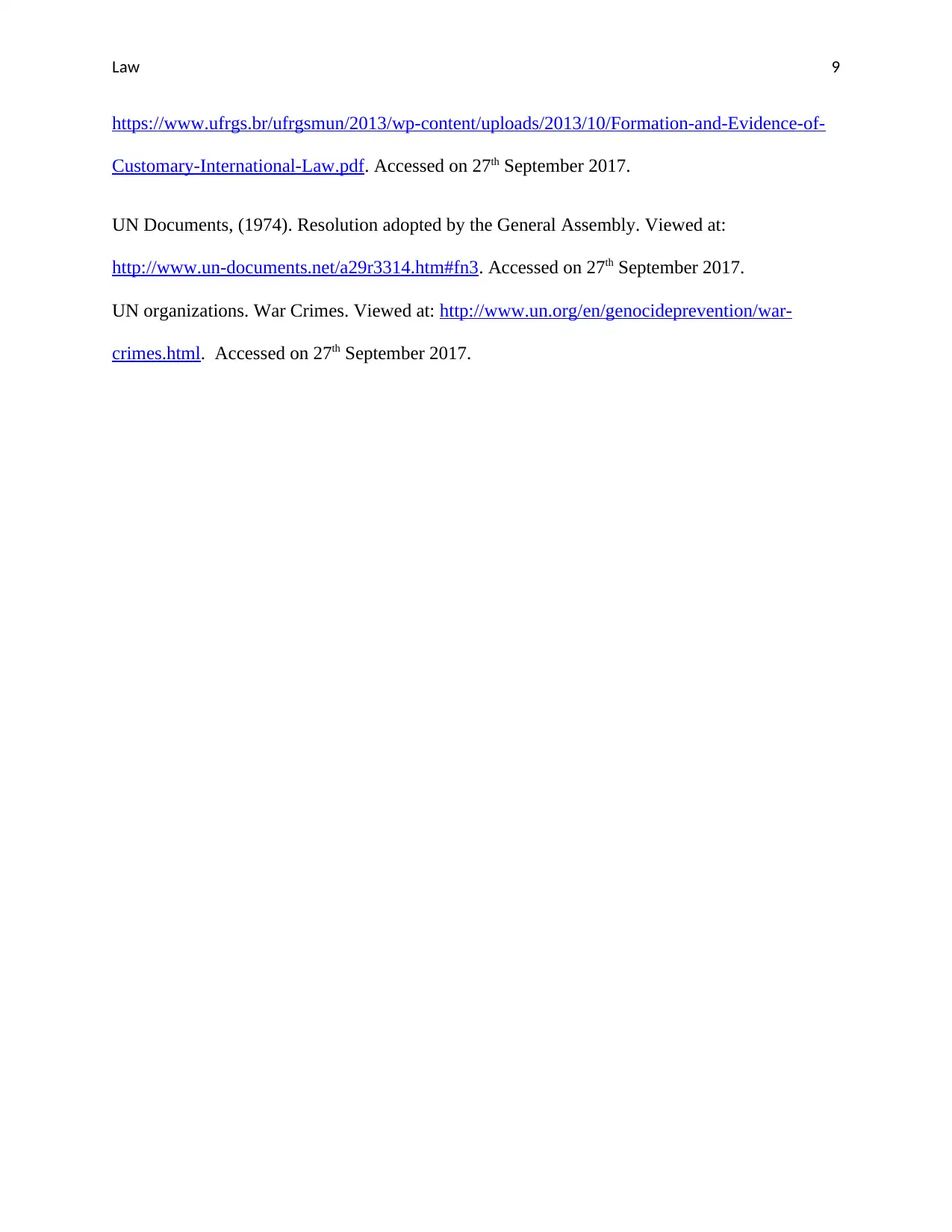
Law 9
https://www.ufrgs.br/ufrgsmun/2013/wp-content/uploads/2013/10/Formation-and-Evidence-of-
Customary-International-Law.pdf. Accessed on 27th September 2017.
UN Documents, (1974). Resolution adopted by the General Assembly. Viewed at:
http://www.un-documents.net/a29r3314.htm#fn3. Accessed on 27th September 2017.
UN organizations. War Crimes. Viewed at: http://www.un.org/en/genocideprevention/war-
crimes.html. Accessed on 27th September 2017.
https://www.ufrgs.br/ufrgsmun/2013/wp-content/uploads/2013/10/Formation-and-Evidence-of-
Customary-International-Law.pdf. Accessed on 27th September 2017.
UN Documents, (1974). Resolution adopted by the General Assembly. Viewed at:
http://www.un-documents.net/a29r3314.htm#fn3. Accessed on 27th September 2017.
UN organizations. War Crimes. Viewed at: http://www.un.org/en/genocideprevention/war-
crimes.html. Accessed on 27th September 2017.
⊘ This is a preview!⊘
Do you want full access?
Subscribe today to unlock all pages.

Trusted by 1+ million students worldwide
1 out of 9
Related Documents
Your All-in-One AI-Powered Toolkit for Academic Success.
+13062052269
info@desklib.com
Available 24*7 on WhatsApp / Email
![[object Object]](/_next/static/media/star-bottom.7253800d.svg)
Unlock your academic potential
Copyright © 2020–2025 A2Z Services. All Rights Reserved. Developed and managed by ZUCOL.




